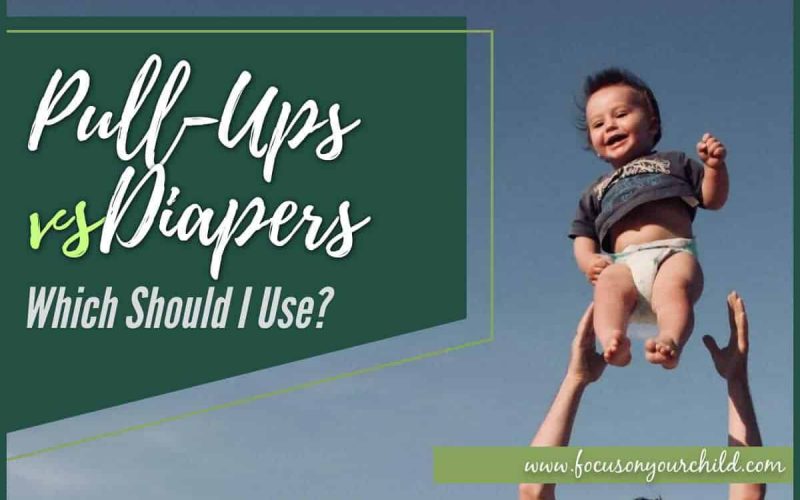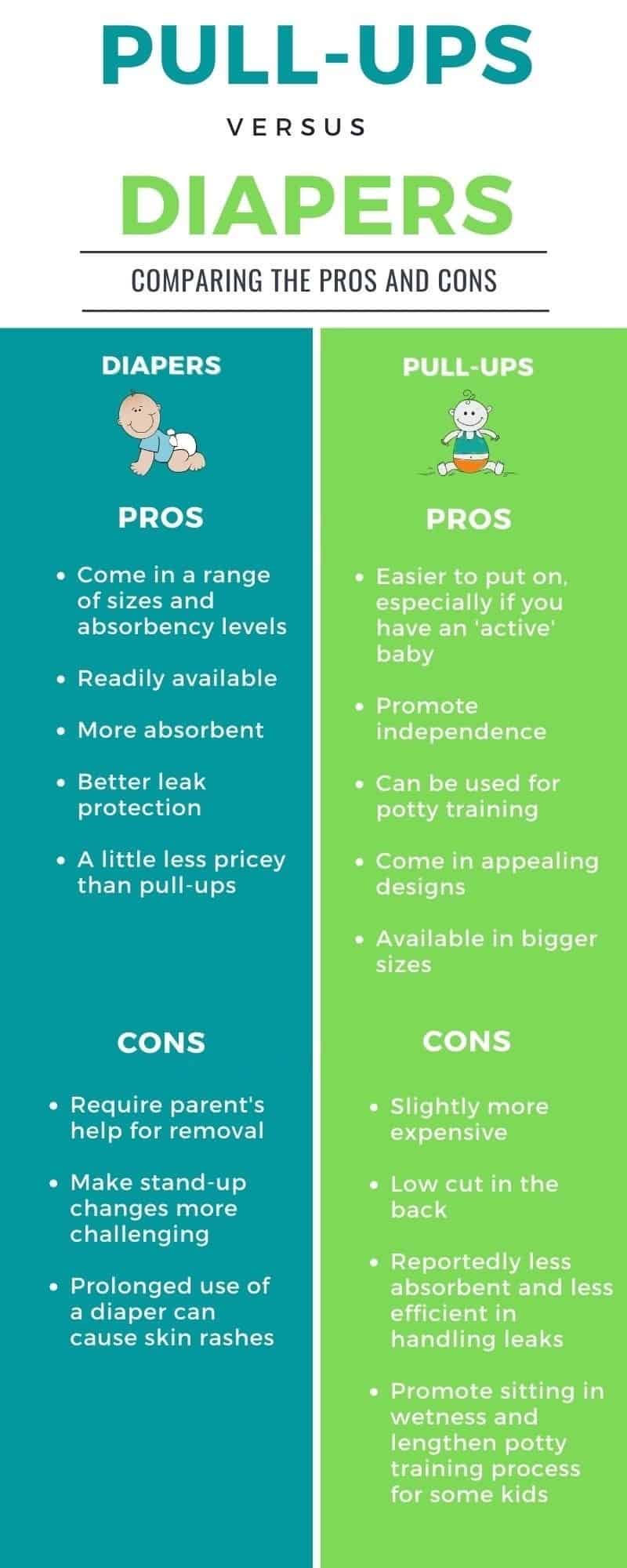Tiny bottoms go through an enormous number of diapers. Just like the many ‘firsts’ that first-time parents experience, diapering can be a little tricky – particularly if you are undecided on which type of diapers to buy. Fortunately, there are options available for every need and lifestyle.
Pull-ups and diapers share many same features. The main difference is that pull-ups work like underwear that are pulled up or down instead of being secured with taped strips at the sides. While both have their benefits, the challenge for parents is finding a solution that works best for their little one.
It is every parent’s goal to make good choices for their children, and diapering is of no exemption. Ideally, as your baby grows, your choices of diapers will also evolve. The pull-ups vs diapers debate can be confusing, and this is what this article is about. Read on to learn about the differences between pull-ups and diapers, their pros and cons, and find out if and when you should make the switch.
So, what are Pull-Up Diapers
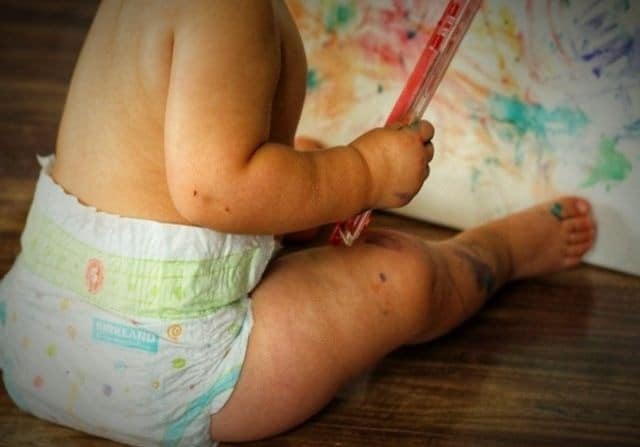
Pull-up diapers are essentially diaper pants with elastic bands. They are made from the same material as diapers but the biggest difference is that they can be pulled up and down like underwear.
Pull-ups are made to look and fit more like regular underwear. They are typically used by toddlers who are very close to the potty-training stage or are actively potty training. The idea is since they can be slipped up and down with ease, pull-ups promote independence on the potty.
New generation pull-ups, however, are recently becoming more popular among many parents. They are known as nappy pants and available in small sizes starting from Size 3 onwards. In this case, nappy pants serve as a replacement for traditional diapers and not for potty training purposes. They are particularly useful for extra active toddlers and when diaper-changing older babies become a battle of wills.
Less bulky and lighter than regular diapers, pull-ups come in fun colors and designs that the little ones will love, like these pull-ups from Pampers for Girls and Boys. Some parents choose to use pull-ups in conjunction with potty training. Many are also using them during nap time and through the night to prevent nighttime accidents.
Pull-Ups vs Diapers: What’s the Difference?
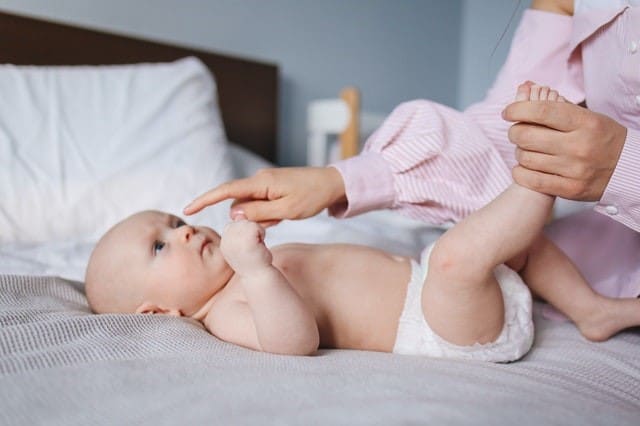
Disposable diapers and pull-ups mostly work the same. They are made out of the same material, making pull-ups essentially just a different style of diaper.
However, the differences between the two extend more than that. Let’s take a closer look at the five main differences between them in terms of design, absorbency, price, size, and usage.
1. Design
Between pull-ups and normal diapers, the most obvious difference is in their design.
Regular diapers are secured in place by two tabs, designed to allow a snuggly fit, and do not easily pull up and down. To take taped nappies off, they need to be undone first, making them great for babies and young toddlers because once they’re on, they stay put.
On the other hand, pull-ups feature an elastic waistband that allows for easy up and down, like a pair of underwear. They are generally easier to put on and take off, making them perfect for standing up changes and are found to be a solution to end the diaper changing wrestling match in older toddlers.
Pull-ups typically feature rip-away sides for changing should messy accidents strike. With their underwear-like convenience, they allow kids to pull them up and down without having to take them off completely, making them exceptionally handy for little ones transitioning to potty training.
2. Absorbency
Both pull-ups and diapers are made of multi-layers of absorbent material for liquid absorption and contain a waterproof outer layer.
Most parents who have used both, however, claim that pull-ups are less absorbent than diapers, and thus are more prone to leaking.
Still, a huge factor for this is the brand of pull up you choose.
Some brands of pull-ups claim to be more absorbent than the regular versions and are specifically designed for toddler use during nighttime.
Just like standard diapers, not all pull-ups are the same.
Certain brands work better and are more comfortable for some kids than others. Factors you need to consider include your child’s size, and how often and how much they typically pee (particularly at night). You may have to experiment with different brands to find one that works best for your little one.
3. Price
When comparing their prices, pull-ups are generally more expensive than diapers. However, the price difference is really not that much as you might expect. Keep in mind, though, that the brand you choose plays a huge role in the pricing, so does the actual style and features of the diaper.
You will find relatively cheaper diapers in the market besides just the big-name brands. That said, comparing a cheaper brand diaper to a branded pull-up diaper, will likely result in a more significant price gap.
4. Size
As you probably already know, disposable diapers come in sizes 1 to 6 and are based on baby weight. Size 1 diapers are for babies from 8 to 14lbs and size 6, the largest diapers, are for little ones weighing over 35 lbs.
On the contrary, pull-ups are sized similarly to clothing and also have corresponding weight recommendations. Since pull up diapers are not really designed for newborns and infants to use, don’t expect to find smaller sizes like you when you go shopping for regular diapers.
Most brands offer pull-ups in four different sizes: 12m-18m (14-26 lbs.), 2T-3T (18-34 lbs.), 3T-4T (32-40 lbs.), and 4T-5T (28-50 lbs.).
5. Usage
Parents often start using pull-ups when they begin potty training their little ones, or at around the age of two.
While many brands claim to be as good as diapers for nighttime use, many parents will tell you based on their experience that this is not true. So, although, you can still use pull-ups overnight, they are not necessarily going to be as absorbent and efficient in handling leaks compared to diapers.
Many parents also find pull-ups particularly handy for when your baby learns to roll and crawl, stand, or walk. Pull-ups can be easily slipped up and down, making standing nappy change easier rather than trying to keep your little champ from flipping over while they are made to lie down for a diaper change.
In addition, pull-ups are overall less bulky than the traditional versions, making them ideal for use during the day or while you are traveling or out of the house.
Pros and Cons of Using Pull-Ups vs Diapers
When buying items for your baby and navigating your options, one of the factors you need to weigh in are the benefits and drawbacks of a product.
Here, let’s take a look at the pros and cons of pull-ups vs diapers in this infographic:
When Should I Use Pull-Ups?
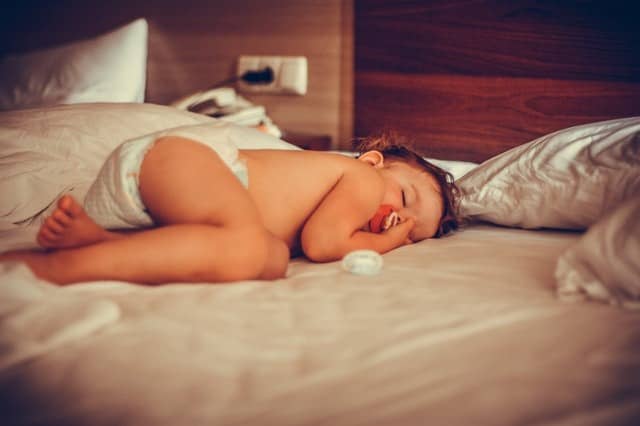
Pull-up diapers do exactly as their name implies – they pull up like regular underwear and come with elastic waistbands and leg openings. While they are generally made of thinner material compared to a regular diaper, they remain absorbent enough to hold any potential messes.
Most parents buy pull-ups these days, as they are convenient. They are found to be the answer for diaper-change resisting tots (no fussing with taped sides while wrestling an active baby or a busy toddler). That said, when your little one starts moving – mastered rolling, crawling, standing, and walking – pull up diaper pants can be a good option.
Many parents also find pull-ups handy, both as a transition to underwear for potty training and for night training. Pull-ups are meant to make your little one feel uncomfortable when wet – which theoretically encourages them to go to the potty rather than pee or poo in his nappy.
Easy to pull up and down when your toddler gets up to use the toilet, for some kids, pull-ups help them feel more independent and improve their self-esteem. A clear step away from diapers, they also give your LO a “big” kid feels, which can motivate them during potty training.
Still, the use of pull-ups for potty training is not a universally-accepted solution. Some parents quit diapers cold turkey, skipping pull-ups completely, and opt to use big-kid underwear to make toilet training a bit faster.
Since pull-ups are designed very much like a regular diaper, some children just don’t know the difference between pull-ups and diapers. They tend to downplay the discomfort and upsetting feeling of having an accident. Wet underwear is much more uncomfortable compare to a wet pull-up diaper — so the latter can be more effective in encouraging them to go to the toilet when they pee or poo.
Using Pull-Ups for Toilet Training
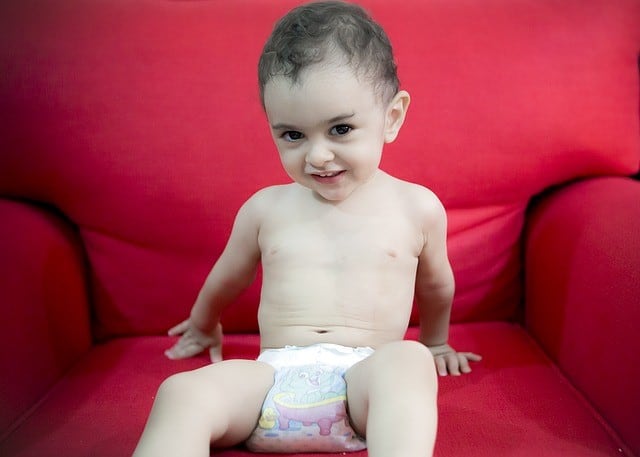
Potty training is a huge milestone for your little one. When it comes to toilet training and nighttime training – like most things in parenting – there isn’t a one-size-fits-all approach guaranteed to work for every kid.
In the end, switching from diapers to pull-ups during potty training is not something that all parents do, nor does it even need to be done.
If you think pull-ups will be helpful for your child during toilet training, there are some things you might want to consider. Should you go this route, you’ll want to introduce pull-ups as training underwear to your little one. Let your child practice pulling them up and down on his own. This will bolster their confidence and motivate them in this milestone. Teach them that their ‘big-kid’ diapers are meant to prevent messy accidents, but the goal is to use the potty.
Another idea is to use pull-ups during the daytime, and continue using regular diapers at night until your kid learns to use the toilet more confidently. Eventually, you can switch to pull-ups during nighttime, too.
While they can work well for others, it is important to remember that every kid is different. Some children will just treat a pull up like a regular diaper, which can delay potty training progress more than necessary.
On the other hand, if your little one has been using pull-ups with success, you don’t want to keep him in pull-ups for too long. He needs to know wearing underwear is the next step. So, how do you know when he is ready to ditch wearing pull-ups? At this point, when your kid is letting you know he needs to use the toilet and is staying mostly dry (an occasional accident is fine), then it is time for underwear.
Above all, keep in mind that potty training isn’t going to happen overnight. According to the American Academy of Pediatrics, starting toilet training before the age of 2 is generally not recommended. In planning your toilet training approach, consider your child’s personality or behavior, as well as your parenting style.
Reinforcing this change is crucial and consistency is key. When you have transitioned your child from diapers to pull-ups, keep him out of diapers. Going back and forth from diapers to pants can create confusion for your kid.
Pull-Ups vs Diapers: The Verdict
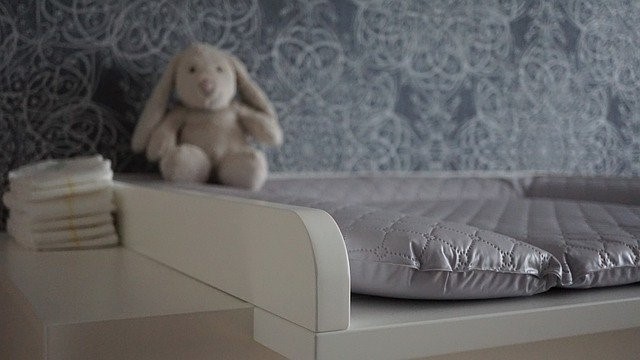
Whether you choose pull-ups or diapers, what’s important is that your little one is comfortable wearing them. Pick a skin-friendly brand for your child. Make sure you change them at regular intervals to keep your baby dry and comfortable. Keeping a wet or soiled diaper on for long periods can cause diaper rashes.
Each option offers benefits and drawbacks, and your experience will also largely rest on the brand you choose. That said, only you can decide if making the switch makes sense for your family. It all depends on your unique circumstances, family lifestyle, and your little one’s age and stage. By keeping the information in this article in mind, you have a better idea of the key differences, benefits, and drawbacks of pull-ups vs diapers to help you come up with the best decision.
